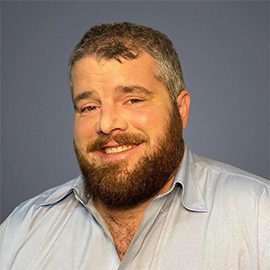TREND Community is honored to introduce Andrew Wright, a person living with myotonic dystrophy type 1 (DM1). Like all of those living with rare and chronic illness, Andrew is so much more than a diagnosis. His story is one of perseverance in the face of challenges. To understand his journey it’s important to look closely at this rare disease.
DM1 is a rare, multisystemic, inherited form of muscular dystrophy that affects an estimated 1 in 2,100 people, or more than 3.6 million individuals across the world. Myotonic dystrophy is the most common form of adult muscular dystrophy and has the largest variability in symptoms. The most common symptoms of DM1 are muscular weakness (95%), followed by fatigue (90%), sleepiness (87%), balance issues (82%), and myotonia (82%).*
Given that it is a genetic condition, DM1 is always present, but in most people, the symptoms initially present in the later teen years or early adulthood. Andrew’s difficulties in his early years involved coordination and an inability to do tasks that required muscle strength (snapping, zipping, tying shoes).
“People would just tell me I was a 98-pound weakling, and after a long time, I began to believe it myself. I just never seemed to get stronger or develop like my peers. I just began to accept this and sort of dismissed it over time.”
When talking with Andrew, it is hard to not be impressed with his intellect, compassion, and understanding of how DM1 has affected his life. As his condition began to manifest, Andrew’s symptoms began to progress in high school in Central Illinois:
“I began having significant issues in my senior year of high school. I was having problems with focus, debilitating apathy and an increased need for excessive amounts of sleep. I was hearing a lot of people around me saying that I wasn’t living up to my potential. That really left me in a very bad state of depression and self-loathing.”
Like many people living with a rare disease, Andrew’s path to a diagnosis wasn’t a straight line. On his way to a diagnosis, he spent time in a hospital for depression:
“Of course, the medicine and therapy I was getting [in the hospital] were not treating my real problem. I was miserable and frustrated, as I couldn’t find out why I was unable to get better. I heard a lot of people telling me to get over it and I just couldn’t shake the feelings.”
As his apathy and isolation continued, new symptoms began to materialize. While at the University of Michigan, he found himself overwhelmed by the volume of work:
“In college, the problems with the central nervous system difficulties continued but other complications began to surface. I was regurgitating food at first a few times a month and then by the time I left college it was [a] weekly occurrence. And the apathy and daytime sleepiness were causing me to have problems attending class, and when I did go, I couldn’t focus on the material.”
Andrew began to attempt to navigate around his symptoms by taking afternoon and evening classes. After much contemplation, he decided to regroup and work toward an associate’s degree. Three-and-a-half years later, he graduated and shortly thereafter opened his own consulting firm.
For Andrew, being self-employed allowed the flexibility he needed; however, the weight of his workload continued to weigh heavily on his life. “Four-and-a-half hours is what I was capable of working.” Selling his company was a hard decision, but Andrew realized investing in his own selfcare was essential.
In his search for answers, Andrew went to a physical therapist to address difficulties with his hand strength. After a brief period of treatment with the therapist, he was referred to a neurologist. The neurologist recognized immediately that Andrew had DM1. However, to confirm the clinical diagnosis, Andrew underwent electromyogram and genetic testing. This culminated in Andrew being able to hear the words he had longed for decades to hear: “I know what you have.” Andrew received his diagnosis of DM1 in 2016, at age 41.
Despite his relief upon finding an answer, Andrew entered a time of denial on his ongoing road to acceptance. There is no disease-modifying treatment or a cure for DM1, and although the symptoms can be managed, every day presents challenges for him. The denial evolved into a desire to help and connect with others, and Andrew reached out to the Myotonic Dystrophy Foundation for support. There he found online resources, information, and connections with support groups.
Today, Andrew spends his days volunteering and offering his perspective as a consultant to and ambassador of people with DM1. His family and his faith empower him and support him to be able to live independently. Andrew has learned to explain DM1 and how it affects him when he makes new acquaintances; he also limits his social interactions according to his limitations:
“It is difficult at times to explain to others why you can’t stay awake or don’t have the energy to go out and do the thing that your friends and family expect you to. It took me quite some time to get others to understand my limitations, and still I have to remind them that I just can’t participate like I would like to.”
When asked what advice he would give to those who are newly diagnosed, Andrew offered these words:
“Don’t procrastinate in seeking help. Write your own narrative, and always remember that you are not your symptoms.”
The echoes of “great potential” and “98-pound weakling” still linger in his mind, but make no doubt about it:
Andrew is a success, and Andrew is strong.
*For additional statistics and information on myotonic dystrophy, please see “The Christopher Project”

